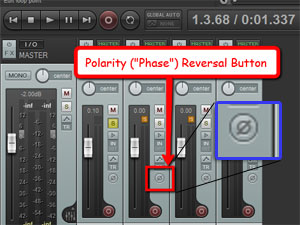 Most mixers have a switch on each channel that will reverse the polarity (often referred to as “phase,” which is not technically correct). To understand polarity, remember that sound happens in waves caused by air moving back and forth – away and toward a microphone. When a blast of air comes toward a microphone, a positive bit of air pressure is picked up. When, an instant later, the wave moves back away from the mic, you get negative pressure picked up. What the polarity switch does is flip them – a positive pressure becomes negative, and vice versa.
Most mixers have a switch on each channel that will reverse the polarity (often referred to as “phase,” which is not technically correct). To understand polarity, remember that sound happens in waves caused by air moving back and forth – away and toward a microphone. When a blast of air comes toward a microphone, a positive bit of air pressure is picked up. When, an instant later, the wave moves back away from the mic, you get negative pressure picked up. What the polarity switch does is flip them – a positive pressure becomes negative, and vice versa.
One very common use for this switch is when you use 2 mics on a snare drum, one on the top and one on the bottom. When the snare drum is hit, the skin moves in and away from a mic that is pointing at the top drum skin – a negative polarity. That same hit causes the bottom head to move outward – toward the bottom mic – a positive pressure. When these two bits of sound wave are put together in the speakers, one will push the speaker out and one will suck it in. So certain frequencies will be negated in that transaction. So it’s almost automatic for mix and live engineers to flip the polarity on the bottom mic so that the drum hit causes both heads to be negative and they will add together instead of subtract audio. This usually results in a better sounding drum with more low-frequency punch.
In this article by Dave Rat, he talks about the use of the polarity switch – when to reverse it and when not to – in order to get a great drum kit sound. Though it is in the “Live Sound” section of the Pro Sound Web Site), the article doesn’t mention it explicitly, but since he mentions the polarity in conjunction with drum monitor speakers, it’s pretty clear he’s talking about the drums in a live music situation. See the full article below:
Article for polarity for drums
Leave a Reply